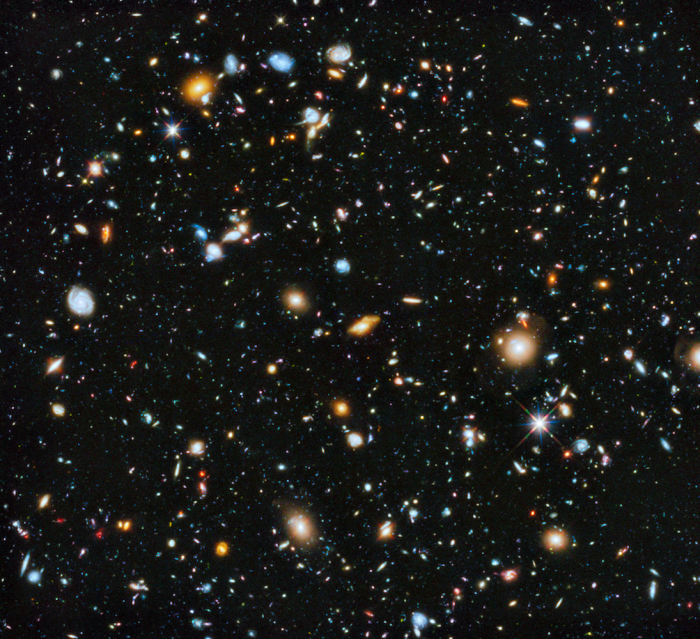Seven little lessons to rediscover our everyday life.
Seven days for the Creation... of a new perspective.
The well-known detail: Every morning we go to work, we take a quick look at the sky, just to see if there is any cloud. We know who we are and what we have to do. Every evening we come back home at nightfall, just when the first stars appear. We never think about the stars and how absurd they are. We have worked, so we know who we are.
The background: We easily forget that the universe is still a total mystery. Its shape, how it began, how it is going to end, what was there before, what is coming after: these are basically fields of speculation. Notwithstanding the huge amount of data collected and evaluated, and despite the numerous theories developed, astrophysicists and cosmologists are often puzzled by what they see. We could say that surprise is the rule in astrophysics.
The matter we are able to see, with our telescopes and other detection instruments, sometimes behaves in such an unexpected way that we need to postulate the existence of something else in order to explain its dynamics.
In other words, since what we observe doesn’t completely add up, there must be something more —and it’s not a small part of it, since we are talking about 95%: researchers conjectured that we can see only 5% of the entire universe.
One of the most complex phenomena to understand is the expansion of the universe.
Immediately after the initial explosion, the universe started expanding very fast; but the gravitational attraction between galaxies slowed down this process and, just like a balloon being almost completely inflated, the universe started to decelerate its expansion. This deceleration led the astronomers to think that in a very distant future everything would stop and cool down. This was the ultimate fate of the universe they envisioned, unless, at a certain point, the process would reverse into the so-called Big Crunch (the opposite of the Big Bang).
This vision remained nearly unchanged during the last century, until in 1998 two different teams of researchers independently made the same disconcerting discovery. It seems that the universe kept on decelerating its expansion during the first half of its existence. And then, some 6 or 7 billion years ago, surprisingly, it started accelerating. Today, galaxies move farther apart much faster than before. How is it possible that they suddenly started to move so fast? What is pushing them away?
Since there is no apparent reason, astronomers hypothesized the existence of an invisible force, called dark energy, which might be responsible for this acceleration. If existing, this energy must be of such a magnitude as to develop the pressure needed to move entire galaxies. To make the math work, dark energy should contribute a 68% of the total energy of the universe; if we add the dark matter (another hypothetical form of matter), we get to 95%—the percentage of the universe whose components cannot be revealed even with our best instruments.
The existence, out there, all around our small planet, of an immense invisible dark ‘force’ playing marbles with galaxies could be an upsetting idea to the most sensitive of us. But the alternative is not comforting either. Indeed, researchers rejecting the hypothesis of the dark energy support something even more paradoxical, at least to the eyes of the laymen: in reality, the universe is not accelerating at all—it is time which is slowing down. According to this theory, the acceleration is only an optical illusion perceived by an observer, like we are, placed inside a spacetime which is slowly coming to a halt.
Things are actually even more bizarre than this. We must consider that what has been said so far relies on the assumption that the laws of physics will always be the same, unchangeable; and until recently everything indicated that the universe had always ‘worked’ in the same manner. Then, in 2010, an Australian study questioned this assumption. Some measurements made by ESO’s Very Large Telescope Project seem to highlight a variation in time of the so-called fine-structure constant – a fundamental quality of electromagnetism that should remain unvaried, constant, as its name suggests. Should it be confirmed, this discovery would imply that the universal laws of physics (gravity, time, space, speed of light, and so on) might not be so universal, and they could vary over time or maybe depending on the ‘area’ of the universe.
The Second Lesson: We live inside a sort of great puzzle, a paradox where the only certainty is that nothing is certain. We cannot even understand what kind of strange place we live in, so how can we always know for sure what we have to do or not to do, what is right and what is wrong? Maybe, only stupid men are certain of everything, as Chuang-Tzu said, as they “believe they are awake, busily and brightly assuming they understand things, calling this man ruler, that one herdsman”. And, when they come back from work, they have no doubts about who they are or what is expected from them, and they never think about the absurdity of the stars.

